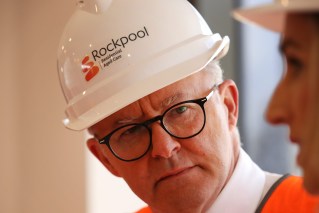On a knife’s edge: RBA says inflation hiccup almost delivered another rates rise
Hotter-than-expected inflation data was enough to prompt discussion of an interest rate rise at the last Reserve Bank of Australia meeting, but staying put was still considered the stronger option.

Governor of the Reserve Bank of Australia (RBA) Michele Bullock. (AAP Image/Bianca De Marchi)
The minutes from the May meeting confirmed the board did devote time to the case to lift interest rates, as already indicated by governor Michele Bullock in the post-meeting press conference.
That was after the March post-meeting write-up did not include any debate about the option to hike above 4.35 per cent, where the cash rate has been for several months.
The meeting was held before the state and federal budgets, as flagged in the document, as well as softer-than-expected wages and jobs data that have since propped up the narrative of a cooling economy.
Ahead of the May meeting, inflation data came in above expectations, the jobs market was proving more robust than thought earlier, and international data was generally pointing to more economic resilience than first anticipated.
“Taken together, these data suggested that there may be somewhat less slack in the economy than previously assessed,” the minutes read.
Underscoring the case to hike was the possibility that judgments underpinning revised staff forecasts, which still had inflation back within target by late 2025, were “overly optimistic”.
Notably, staff predictions put a lot of weight into the ongoing weakness of the consumer, and there was a risk that spending could pick up.
A drift higher in inflation expectations or a failure to return to normal productivity growth trends were further risks to the inflation fight and possible reasons to jack the cash rate up further.
Keeping the cash rate steady was the “stronger” choice, however, and that was premised on the view that upside data surprises were not large enough to warrant more tightening.
“Importantly, inflation expectations remained well anchored,” the minutes stated.
“Given this, and the higher-than-usual level of uncertainty about the economic outlook, members judged that it remained reasonable to look through short-term variation in inflation to avoid excessive fine-tuning.”
Yet fears of hard-to-budge inflation and the possibility of another interest rate hike appear to be weighing on consumer confidence.
The latest update from Westpac and Melbourne Institute, which sampled the populace following stronger-than-expected March quarter inflation data as well as last week’s federal budget, showed a modest 0.3 per cent decline in the overall index.
This followed falls across the past two readings, with consumers at their most confident back in February.
Westpac senior economist Matthew Hassan said consumer sentiment remained deeply pessimistic.
“While expectations improved a touch in May, this was overshadowed by a further deterioration in current conditions and fears that persistently high inflation may require further interest rate rises,” Mr Hassan said.
As is typical of confidence surveys around federal budgets, sentiment lifted heading in and fell afterwards, which suggested some disappointment.
“Although a closer reading of the survey suggests this may have been more around the difficult economic context that the budget highlighted than its content,” Mr Hassan said.












